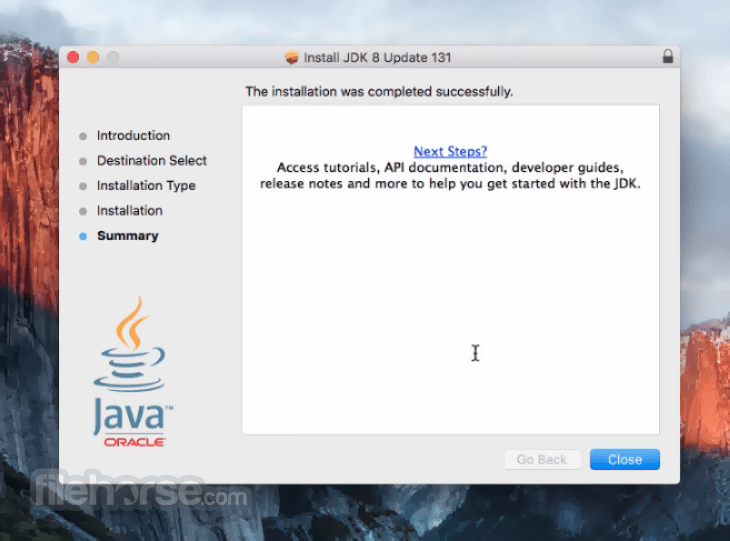See JDK 7 and JRE 7 Installation Guide for general information about installing JDK 7 and JRE 7.
Important Notice! Java SE 6 represents the latest release of the Java Platform, Standard Edition. Customers are encouraged to migrate today. » Read More Release 1.4 of the Java 2 Platform, Standard Edition (J2SE) represents an advance from J2SE 1.3.
See the Mac OS X Platform Install FAQ for general information about installing JDK 7 on Mac OS X.
Contents
System Requirements
- Any Intel-based Mac running Mac OS X 10.7.3 (Lion) or later.
- Administrator privileges.
- Click the 'Java' option. Click 'Java SE.' Click the 'Download' button next to 'JDK 8 with NetBeans.' Select 'Accept License Agreement' and then click the download link for 'Mac OS X' in the top section. This is the most recent release of the Java SDK with the NetBeans development environment.
- Eclipse SDK is a cross platform integrated development environment that makes it easy and straightforward for you to work on various development projects like Java files, graphics, web content and more. Highly customizable development environment, easily extendable using plug.
Note that installing the JDK on a Mac is performed on a system wide basis, for all users, and administrator privileges are required. You cannot install Java for a single user.
Installing the JDK also installs the JRE. The one exception is that the system will not replace the current JRE with a lower version. To install a lower version of the JRE, first uninstall the current version.
JDK 7 Installation Instructions
Installation of the 64-bit JDK on Mac Platforms
When you download the Java Development Kit (JDK), the associated Java Runtime Environment (JRE) is installed at the same time. The JavaFX SDK and Runtime are also installed and integrated into the standard JDK directory structure.
Depending on your processor, the downloaded file has one of the following names:
- jdk-7u<version>-macosx-amd64.dmg
- jdk-7u<version>-macosx-x64.dmg
Where <version> is 6 or later.
1. Download the file. Before the file can be downloaded, you must accept the license agreement.
2. From either the Downloads window of the browser, or from the file browser, double click the .dmg file to launch it.
3. A Finder window appears containing an icon of an open box and the name of the .pkg file Double click the package icon to launch the Install app.
4. The Install app displays the Introduction window. Click Continue.
4a. Note that, in some cases, a Destination Select window appears. This is a bug, as there is only one option available. If you see this window, select Install for all users of this computer to enable the continue button. Click Continue.
5. The Installation Type window appears. Click Install.
6. A window appears which says 'Installer is trying to install new software. Type your password to allow this.' Enter the Administrator login and password and click Install Software.
7. The software is installed and a confirmation window appears. Click the ReadMe for more information about the installation.

After the software is installed, delete the dmg file if you want to save disk space.
Determining the Default Version of the JDK
A: If you have not yet installed Apple's Java Mac OS X 2012-006 update, then you are still using a version of Apple Java 6 that includes the plug-in and the Java Preferences app. See Note for Users of Macs that Include Apple Java 6 Plug-in.
There can be multiple JDKs installed on a system – as many as you wish.
When launching a Java application through the command line, the system uses the default JDK. It is possible for the version of the JRE to be different than the version of the JDK.
You can determine which version of the JDK is the default by typing java -version in a Terminal window. If the installed version is 7u6, you will see a string that includes the text 1.7.0_06. For example:
To run a different version of Java, either specify the full path, or use the java_home tool:
For more information, see the java_home(1) man page.
Uninstalling the JDK
To uninstall the JDK, you must have Administrator privileges and execute the remove command either as root or by using the sudo(8) tool.
Navigate to /Library/Java/JavaVirtualMachines and remove the directory whose name matches the following format:*
For example, to uninstall 7u6:
Do not attempt to uninstall Java by removing the Java tools from /usr/bin. This directory is part of the system software and any changes will be reset by Apple the next time you perform an update of the OS.
Java 2 Sdk Mac Os
*The 7u4 and 7u5 releases were installed into a directory that does not follow this format. To uninstall 7u4 or 7u5, remove the 1.7.0.jdk directory from the same location.

The first requirement to uninstall Java on Mac OS – you should have administrator privileges.
Second – you shouldn’t be afraid to use terminal.
This method works fine for any version of Java – 8, 9, 10, 11, 12, 13 or any other version.
Uninstalling Java on the Mac
- Click on Launchpad in the
dock - Search for Terminal and open it.
- Copy and paste commands to uninstall Java completely
sudo rm-fr/Library/Java/JavaVirtualMachines/jdk-9.0.1.jdk |
That’s it! Java is successfully deleted.
Related posts: